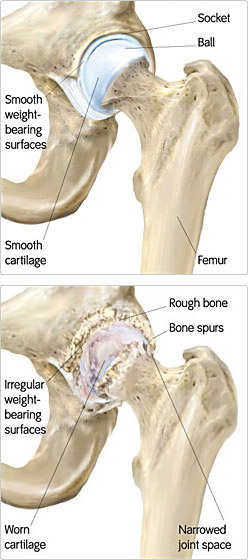Osteoarthritis of the hip is a disease which wears away the cartilage between the femoral head and the acetabulum, eventually causing the two bones to scrape against each other, raw bone on raw bone. When this happens, the joint becomes pitted, eroded and uneven. The result is pain, stiffness and instability, and in some cases, motion of the leg may be greatly restricted.
Patients with osteoarthritis often develop large bone spurs, or osteophytes, around the joint, further limiting motion.
Osteoarthritis is a common, degenerative disease, and although it most often occurs in patients over the age of 50, it can occur at any age, especially if the joint is in some way damaged.
Causes
Osteoarthritis of the hip is a condition commonly referred to as "wear and tear" arthritis. Although the degenerative process may accelerate in persons with a previous hip injury, many cases of osteoarthritis occur when the hip simply wears out. Some experts believe there may exist a genetic predisposition in people who develop osteoarthritis of the hip. Abnormalities of the hip due to previous fractures or childhood disorders may also lead to a degenerative hip. Osteoarthritis of the hip is the most common cause for both total hip replacement and hip resurfacing.
Symptoms
The first and most common symptom of osteoarthritis is pain in the hip or groin area during weight bearing activities such as walking. People with hip pain usually compensate by limping, or reducing the force on the arthritic hip. As a result of the cartilage degeneration, the hip loses its flexibility and strength, and may lead to the formation of bone spurs. Finally, as the condition worsens, the pain may be present all the time, even during non weight-bearing activities.

